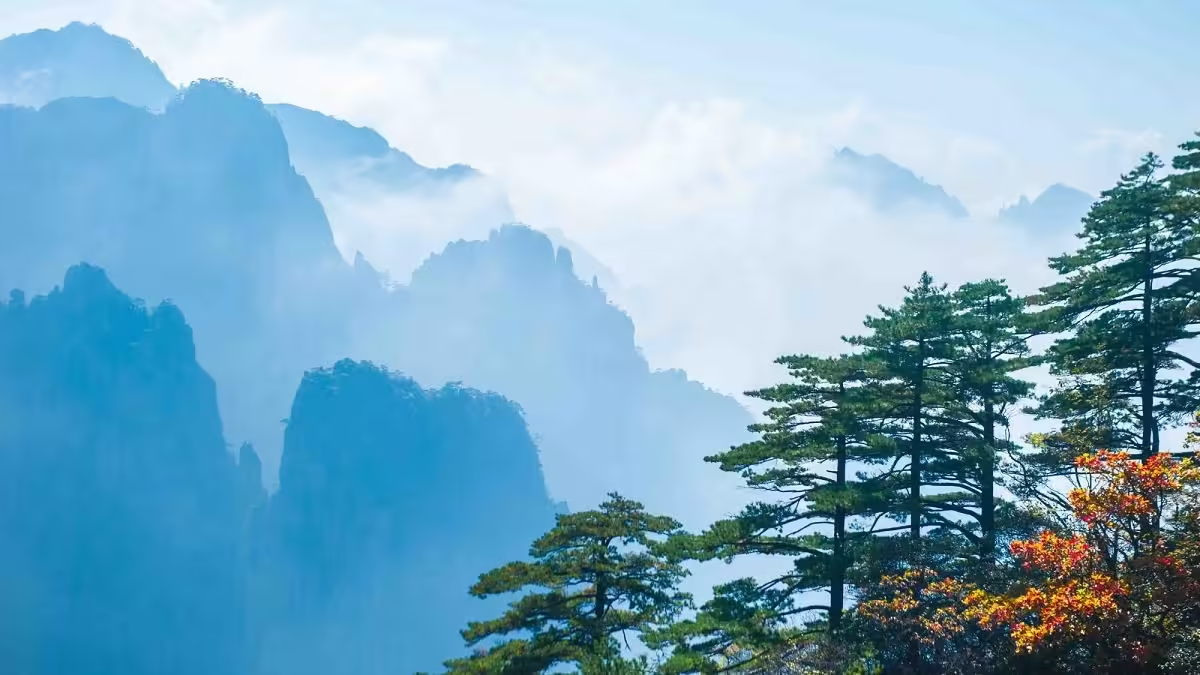Huangshan Mountain (黄山, Mount Huang, Mount Huangshan), located in the southern part of Anhui Province, is one of China’s top ten famous mountains and is renowned as the “most spectacular mountain under heaven.” It boasts 72 peaks, with the main peak, Lotus Peak, standing at an altitude of 1,864 meters. Along with Bright Summit and Heavenly Capital Peak, it is one of the three main peaks of Huangshan and one of the 36 major peaks. Huangshan is the symbol of Anhui tourism and the only mountain scenery among China’s top ten scenic spots. It is recognized as a UNESCO World Cultural and Natural Heritage site, a Global Geopark, a national AAAAA tourist attraction, and a national scenic area.
Originally named “Yishan,” Huangshan received its name due to the dark, greenish-black peaks and rocks, which appeared dark from a distance. Later, the mountain was renamed “Huangshan” in honor of the legendary Emperor Yellow (Huang Di), who is said to have refined elixirs here. Huangshan is famous for its “Five Wonders and Three Waterfalls.” The Five Wonders are: strange pines, peculiar rocks, sea of clouds, hot springs, and winter snow. The Three Waterfalls are: the Renzi Waterfall, Baizhang Spring, and Jiulong Waterfall. The Welcome Pine on Huangshan is a symbol of the warmth and friendliness of the people of Anhui, embodying the hospitality and culture of the East.
The scenic area is divided into the Front Mountain and the Back Mountain. The Front Mountain refers to the area from Ciguang Pavilion to Bright Summit, including the Hot Springs, Jade Screen Pavilion, and Heavenly Sea scenic areas. Key attractions include the Welcome Pine, Halfway Temple, Heavenly Capital Peak, Jade Screen Pavilion, Lotus Peak, One-Line Sky, and Fish Peak. The Back Mountain refers to the area from Cloud Valley Temple to Bright Summit, including the Beihai and Xihai scenic areas. Major attractions here include Beginning-to-Believe Peak, Lion Peak, Paiyun Pavilion, Xihai Grand Canyon, Flying Rock, and Songgu Nunnery. The scenic area has three entrances: South Gate, West Gate, and North Gate. Most visitors enter and exit through the South Gate, which has entrances to both the Front and Back Mountains, both located near Tangkou Town at the foot of the mountain.
When the Ming Dynasty traveler Xu Xiake visited Huangshan, he marveled, “Among the famous mountains, none surpass Huangshan in Anhui. After climbing Huangshan, no other mountain is worth seeing.”
Table of Contents
- Basic Information
- Location and Transportation
- Highlights of Huangshan Mountain
- Climate in Huangshan Mountain
- Geology of Huangshan Mountain
Basic Information
| Estimated Length of Tour | 1 – 2 days |
| Ticket Price | 150 RMB (20th December – 20th January) 190 RMB (21st January – 19th December) |
| Cable Car | 20th December – 20th January (Single Way): Yungu Cable Car (云谷索道): 65 RMB Taiping Cable Car (太平索道): 75 RMB Yuping Cable Car (玉屏索道): 80 RMB 21st January – 19th December (Single Way): Yungu Cable Car (云谷索道): 80 RMB Taiping Cable Car (太平索道): 90 RMB Yuping Cable Car (玉屏索道): 100 RMB |
| Opening Hours | 7.00 – 17.10 |
| Telephone Number | 0086-0559-5561111 |
Location and Transportation
Huangshan Mountain is located in Huangshan District, Huangshan City, in the southern part of Anhui Province, China. The scenic area covers about 160.6 square kilometers within a total area of approximately 1,200 square kilometers. The mountain range extends from Huangshi in the east to Xiaolingjiao in the west, from Erlong Bridge in the north to Tangkou Town in the south.
To reach Huangshan Mountain, visitors can first take a train to Huangshan North Railway Station. From there, transfer to a tourist shuttle bus to the mountain. Buses to the southern gate of Huangshan start operating at 9:00 AM, with departures every half hour. There is also a bus to the northern gate, which departs at 12:40 PM.
Highlights of Huangshan Mountain
Yuping Scenic Area (Jade Screen Scenic Area)
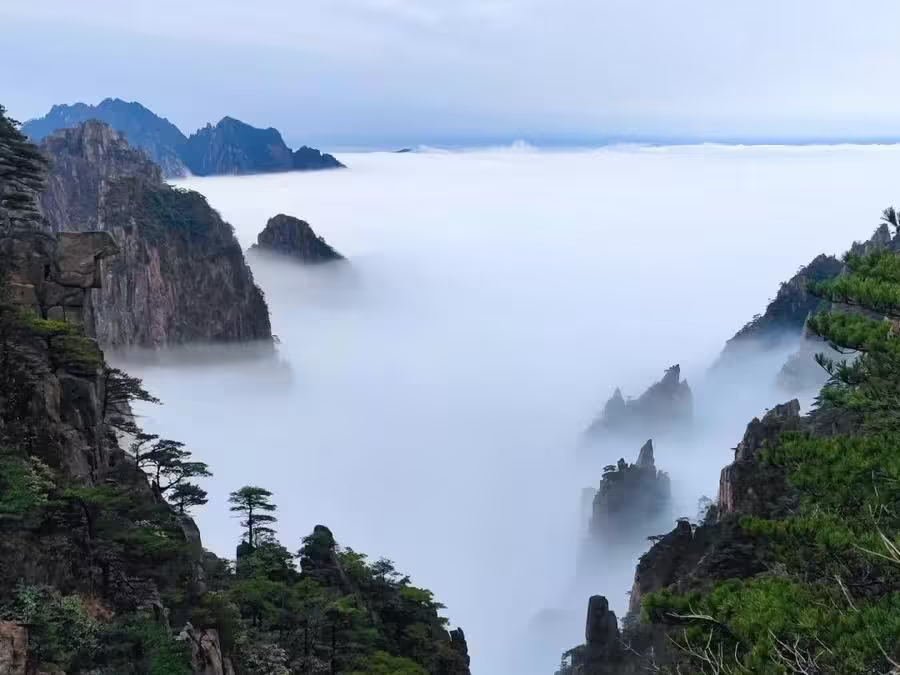
The Yuping Scenic Area of Huangshan centers around the Jade Screen Pavilion, with Lotus Peak and Heavenly Capital Peak as its main attractions. This area is commonly referred to as the Front Mountain. Along the way, visitors can see several famous sights, including “The Three Islands of Penglai,” “Hundred-Step Cloud Ladder,” “One-Line Sky,” “New One-Line Sky,” and “Fish Peak Cave.”
The Jade Screen Pavilion is located between Heavenly Capital Peak and Lotus Peak, and it is often regarded as the epitome of Huangshan’s breathtaking scenery, earning the title of “The Best Place on Huangshan.” The world-famous Welcome Pine stands proudly to the left of the pavilion, while the Farewell Pine is on the right. In front of the pavilion is the Guest-Greeting Pine, the Manjusri Terrace, and behind it lies Jade Screen Peak, where the famous “Reclining Buddha” formation can be found. The formation, with its head to the left and feet to the right, is remarkably lifelike.

Heavenly Capital Peak is located one kilometer south of Jade Screen Peak and is the most perilous of Huangshan’s three main peaks, with an elevation of 1,830 meters. The path to the summit is extremely steep, but thanks to the efforts of the builders, the route has become thrilling yet safe. At the summit of Heavenly Capital Peak, an inscription reading “Climbing to the Top” evokes a sense of achievement, capturing the sentiment “Where the sea ends, the sky begins; atop the highest peak, I stand above all.”
Lotus Peak, located to the north of the Jade Screen Pavilion, is the highest peak of Huangshan, rising to an altitude of 1,864.8 meters. The peak is steep and towering, resembling a lotus flower just beginning to bloom, which is how it got its name. The path from Lotus Ridge to the summit, known as the Lotus Stem, is about 1.5 kilometers long. Along the way, visitors can admire famous Huangshan pines such as the Flying Dragon Pine and the Inverted Pine, as well as the Huangshan azaleas. The summit of Lotus Peak is a small area about a square meter in size, with a well called the Fragrant Sand Well in the center. On a clear day, visitors can gaze eastward at Tianmu Mountain, westward at Mount Lu, and northward at Mount Jiuhua. After rain, the sight of the sea of clouds from all directions is particularly awe-inspiring.
Beihai Scenic Area (North Sea Scenic Area)
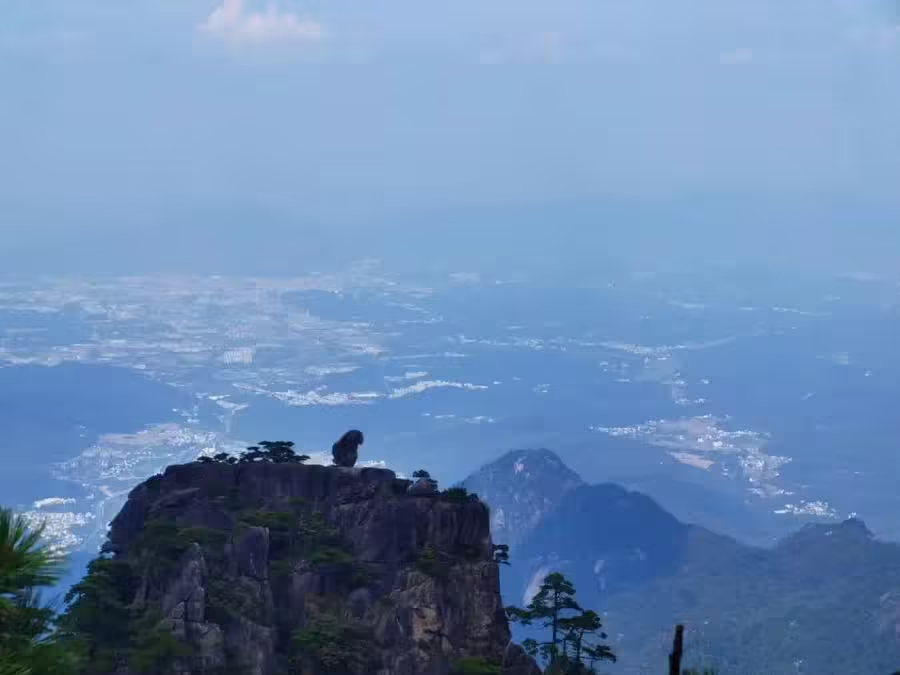
The Beihai Scenic Area is located in the heart of Huangshan, nestled between Bright Summit, Beginning-to-Believe Peak, Lion Peak, and White Goose Ridge. It is connected to the Cloud Valley Scenic Area to the east, the Yuping Scenic Area to the south, and is near the Songgu Scenic Area to the north. This high-altitude open area sits at around 1,600 meters above sea level and spans 1,316 hectares.
Beihai Scenic Area is renowned for its magnificent peaks, strange rocks, and stunning pines, clouds, and unique stone formations. It is characterized by its grandeur, mystery, steepness, and illusionary beauty. The natural landscape here, with its remarkable and ever-changing colors, creates a series of majestic, strange, and mystical scenes, making it the scenic window of Huangshan.

The area is home to an impressive collection of peaks, including Shimen Peak and Gongyang Mountain, both of which rise above 1,800 meters, forming a natural barrier between the north and south. Lion Peak, at an elevation of 1,690 meters, lies horizontally across the scenic area, with its head facing east and its tail to the west. The Cooling Terrace on Lion Peak is the best spot to enjoy the sea of clouds and the sunrise.
Beihai is one of the main high-altitude scenic areas and serves as a key sightseeing and reception area. Centrally located in Huangshan, it is accessible by paths from the east, west, south, and north. Additionally, Beihai features several smaller trails connecting various attractions, forming a network that naturally draws a large number of visitors.
Songgu Scenic Area (Pine Valley Scenic Area)

Huangshan is often described as “steep in the front, elegant in the back,” with the back referring to the Songgu Scenic Area, located at the northern entrance of Huangshan. The Songgu Scenic Area is nestled on the northern slope of Huangshan and encompasses the valleys between Lion Peak, Camel Peak, Shuxiang Peak, and Pagoda Peak. For visitors arriving at Huangshan’s northern gate in Taiping, the best route is to enter the mountain through the Furong Ridge.
Hiking up from Furong Ridge involves climbing over 6,500 stone steps, with an elevation gain of 1,100 meters. Along the way, you’ll encounter a stunning array of peaks and valleys, with particularly exquisite rock formations and famous pools. The ancient buildings in the valley, such as “Furong Residence” and “Songgu Zen Forest,” add a mysterious charm to this tranquil and secluded valley.

One of the highlights of the Songgu Scenic Area is the cliffside stone inscriptions, which are well worth a visit. During the rainy season, the area is renowned for the famous “Songgu Listening to the Waves” scenic spot. Visitors to the Songgu Scenic Area can also enjoy views of well-known peaks such as Furong Peak, Danxia Peak, Songlin Peak, and Shuangsun Peak, as well as unique rock formations like Immortal Watching the Sea, Immortal Paving the Road, Tiger Carrying the Sheep, Guan Gong Blocking Cao, and Crouching Tiger Rock. Additionally, the area boasts water features like Emerald Pool and Wulong Pool, as well as ancient structures like Furong Residence and Songgu Zen Forest.
Hot Spring Scenic Area
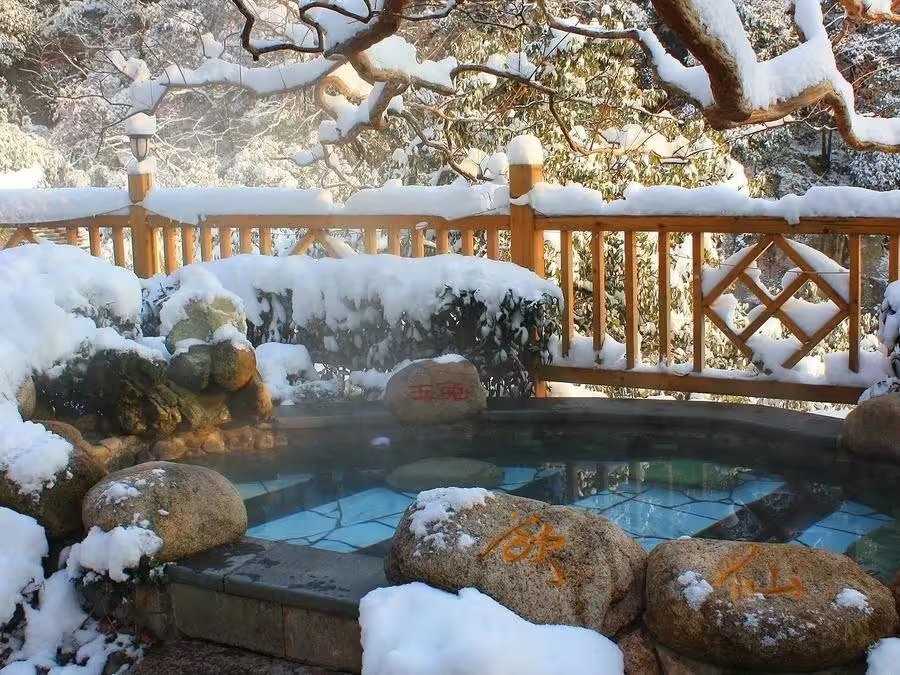
The Hot Spring Scenic Area of Huangshan, historically known as “Taoyuan Wonderland,” centers around Lansheng Bridge and radiates outward, with Taohua Creek and Xiaoyao Creek flowing through it. The hot springs are one of Huangshan’s “Five Wonders,” historically referred to as “Tangquan” or “Zhushui Spring.” According to the Song Dynasty text Huangshan Tujing, it is said that the legendary Yellow Emperor, the ancestor of the Chinese people, once bathed here, rejuvenating himself and gaining immortality. This legend greatly enhanced the spring’s reputation, earning it the name “Lingquan,” or “Sacred Spring.”
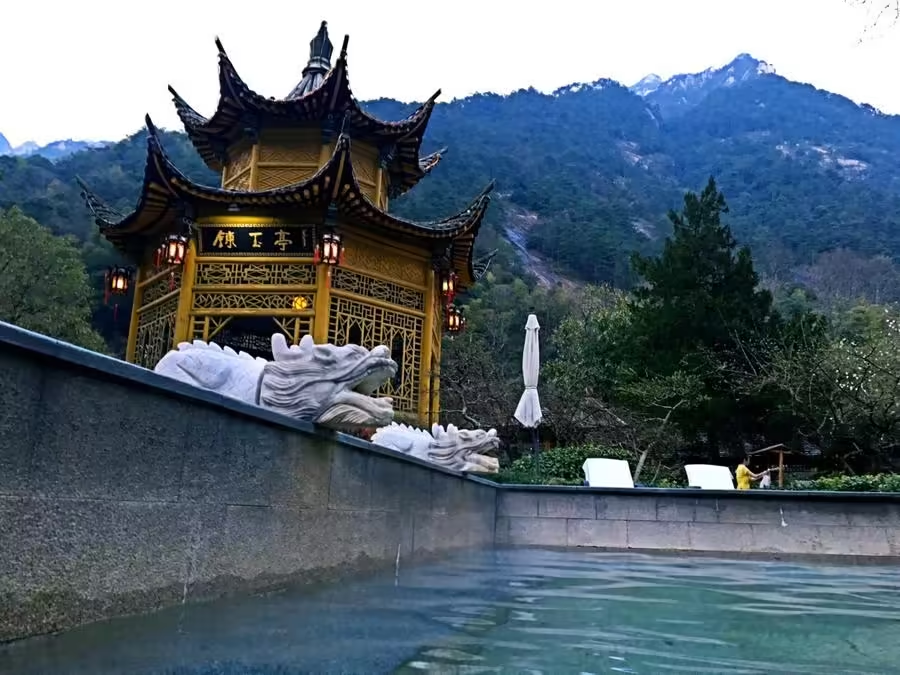
The hot springs are located on the southern slope of Zishi Peak, on the northern bank of Tangquan Creek, at an elevation of 650 meters. The main spring has an average temperature of 42.5°C, while the secondary spring has a temperature of 41.1°C. The water temperature fluctuates with changes in air temperature and rainfall. The maximum flow rate of the springs can reach up to 219.51 tons per day, with a minimum flow rate of 145.23 tons.
Key attractions in the Hot Spring Scenic Area include Renzi Waterfall, Sanjie Spring, Taohua Creek, Taohua Pond, Mingxian Spring, and Guanfeng Tower.
Baiyun Scenic Area (White Cloud Scenic Area)

The Baiyun Scenic Area is located in the western part of Huangshan, covering an area of 1,655 hectares. It stretches from Xugu Bridge on Yunmen Creek in the south to Funiu Ridge in the north, and from Yunji and Shiren Peaks in the east to Shuanghekou in the west. The scenic area is centered around Diao Qiao An, which is situated under Shiren Peak, at the confluence of Baiyun and Baimen Creeks, at an elevation of 610 meters. Diao Qiao An, also known as Baiyun An, was originally a Taoist temple before being converted into a Buddhist temple during the Kangxi period of the Qing Dynasty. The name has persisted to this day.
Climate in Huangshan Mountain
Huangshan is located in a subtropical monsoon climate zone, specifically at the northern edge of the central subtropical region, characterized by evergreen broad-leaved forests and red-yellow soil. Due to the mountain’s high altitude and deep valleys, the climate exhibits vertical variation. Additionally, the significant difference in solar radiation between the northern and southern slopes, combined with the influence of local topography, results in a climate with frequent clouds, high humidity, and abundant precipitation, resembling a maritime climate. Summers are not excessively hot, and winters are not severely cold, with the average temperature difference between seasons being only around 20°C. The highest summer temperature reaches 27°C, while the lowest winter temperature drops to -22°C. The annual average temperature is 7.8°C, with an average summer temperature of 25°C and an average winter temperature above 0°C. The mountain experiences an average of 183 rainy days per year, mostly concentrated between April and June, with an annual precipitation of 2,395 millimeters. The southwestern and northwestern winds are more frequent, and the mountain has an average of 49 snowy days per year.
Geology of Huangshan Mountain
Huangshan Mountain’s unique peak forest structure has been shaped by a long history of orogeny, crustal uplift, and the effects of glaciation and natural weathering. The mountain range consists of 72 peaks, traditionally known as “Thirty-Six Major Peaks and Thirty-Six Minor Peaks,” with the main peak, Lotus Peak, reaching an elevation of 1,864.8 meters.
The mountain is primarily composed of granite from the Yanshanian period, characterized by well-developed vertical joints, intense erosion, and complex networks of fractures and fissures. Over time, water erosion has created a stunning array of granite caves and tunnels. The landscape features multiple ridges and valleys, with 30 ridges, 22 rocks, 7 caves, and 2 passes spread throughout the mountain.
The Quaternary glacial relics of Huangshan are mainly found in the southeastern part of the Front Mountain. Notable glacial landforms include the “U”-shaped valleys of Kuzhu Stream and Xiaoyao Stream, formed by glacial movement; the ridges of Meimao Peak and Jiyu Ridge, which are remnants of two “V”-shaped valleys and glacial erosion; the horn peak at the summit of Heavenly Capital Peak, shaped by glacial cirques on three sides; and the hanging valleys formed by the convergence of glacial valleys at Baizhang Spring and Renzi Waterfall. In addition, glacial till deposits can be found in the riverbed terraces from Xiaoyao Stream to Tangkou, Wuniguan, and Huangshidang. The “Elixir Well” and “Medicine Mortar,” which are traditionally believed to have been used by the Yellow Emperor for alchemy, are also glacial potholes formed by glacial activity.

